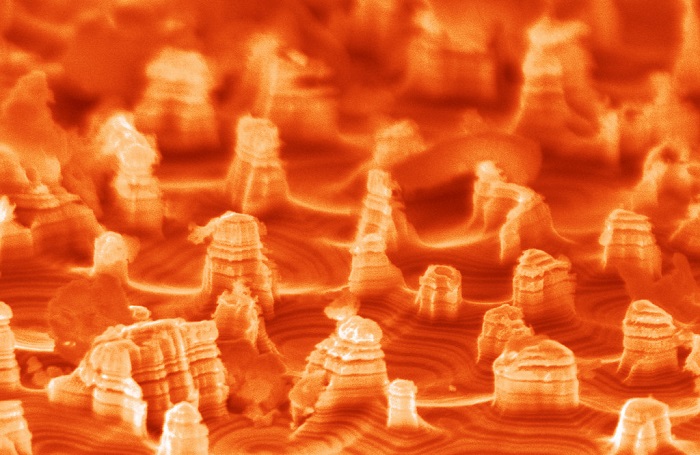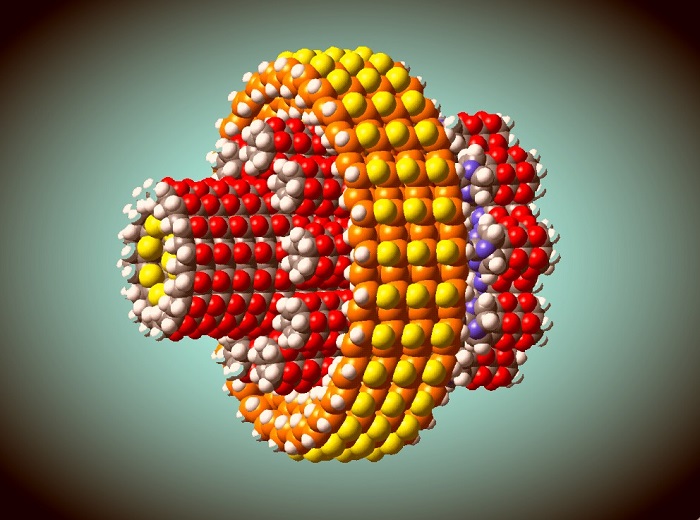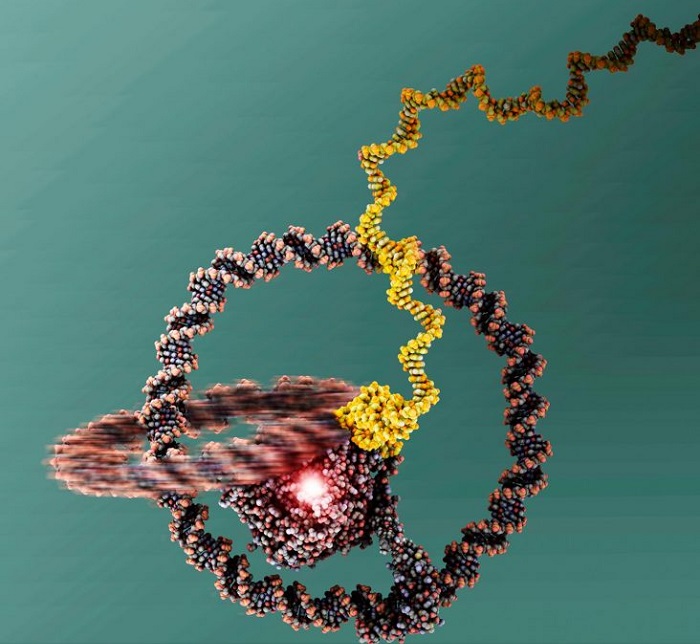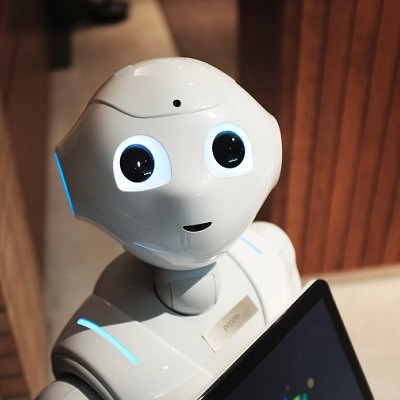They’re tiny machines that work on the nanoscale, being up to 100,000 times smaller than the width of a human hair. These machines, otherwise known as nanorobotics, are set to augment the human race in unforeseen ways.
However, this microscopic technology has remained in the prototype phase for the past two decades, failing to truly live up to its promise, and lagging due to difficult manufacturing processes, a lack of standardization, and scant reviews of the available literature.

Nanoscale canyons.
Picture a scenario where you’re ill and need to see your doctor. However, instead of giving you a pill or a shot, your doctor injects you with a swarm of tiny robots.
These nanomachines will then work together autonomously to scan their environment and detect your illness — after which they travel to the relevant organ to deliver a payload of slow-release medication deep within the infected area to cure you.
Sounds pretty sci-fi, right? Well, it may not be that far off.
This science is based on nanotechnology, a field of innovation concerning the building of materials and devices at the atomic and nanoscale. To give you a sense of how minute this scale is, a nanometre is just one-billionth of a meter, also known as the billionth-scale.
Because of this small scale, many of the ordinary rules of physics and chemistry no longer apply here, proffering unforeseen and alienlike properties. An example of these quantum-based properties is matter constructed in the nanoscale known as metamaterials.
One such material composed of carbon atoms is 100 times stronger than steel but six times lighter. Other metamaterials, such as quantum dots, can produce far more power than conventional solar or electrical cells despite being zero-dimensional. Remarkably, these nanoscale substances are predicted to produce an abundance of innovative materials used in manufacturing the world over, helping to end poverty and hunger, and possibly ushering in a period of peace and prosperity.
But things haven’t developed as quickly as many hoped.
What is nanorobotics?
Most theoreticians credit the concept of nanotechnology to physicist Richard Feynman and his speech in 1959 entitled: “There’s Plenty of Room at the Bottom”. In the speech, Feynman predicted the development of machines that could be miniaturized and huge amounts of information being encoded in minuscule spaces. However, it was K. Eric Drexler’s 1986 book, Engines of Creation: The Coming Era of Nanotechnology, which galvanized nanotechnological doctrine.
Drexler floated the idea of programmable, self-replicating nanodevices. In effect, these ‘nanorobots’ would contain a blueprint to clone and build themselves, and any other device needed to fulfill their function. As this construction would take place on an atomic scale, these nanomachines would be able to pull apart any kind of material atom by atom and manufacture never-before-seen devices. Drexler conceived of a universe where nanorobots could perform tasks such as environmental cleaning and clear the human blood capillary system of toxins. The possibilities he theorized involving nanotechnology hinted at addressing contemporary global challenges and future dilemmas, with almost limitless potential once commercialized.
In a practical sense, nanorobotics refers to nanoscale robots, which can accurately build and manipulate objects on a molecular scale. A leading study on the subject in The Frontiers journal series uses the term micro/nanorobots to refer to all nano- to micron-size programmable devices capable of traveling in the nanoscale using a power source. The process they describe there is the actuation or propulsion of nanomachines which they file into three categories.
The first category encompasses biohybrid systems integrating synthetic materials with motile microorganisms acting as engines using their natural appendages. The next category involves chemically powered micro/nanorobots that are capable of converting chemical fuels into locomotion. And finally, the most populated category covers mechanically powered nanorobots that use external energy sources such as magnetic, ultrasound, or light fields to move.

A schematic of a molecular planetary gear, an example of nanomachinery.
The study also collates the percentage of nanobots within each category that have been trialed in living biological systems. They state that, as of 2018, 20% of biohybrid nanorobots, 30% are chemical nanomachines, and 50% of all mechanical systems in existence have been used inside living animals in trials.
Despite remarkable progress, many hurdles exist when manufacturing at the billionth scale, in a process known as nanomanipulation which is performed under electron or scanning probe microscopy using tools such as optical and magnetic tweezers or grippers. Here, nanodevices are being manipulated and welded or soldered together at the molecular scale making the process expensive and time-consuming, and commercialization unfeasible. As it stands, the whole field of nanotechnology, including nanorobotics, is heavily reliant on the development of nanomanipulation.
The types of nanorobotics
Nanorobotics falls into four broad groupings.
1- The first classification encompasses purely mechanical nanobots containing no biological material. Here, physically powered nanorobots constructed of synthetic and/or metallic material can be actuated via a chemical reaction or external energy inputs such as magnetic, ultrasound, and light fields. These nanobots are intricate on the billionth scale, containing joints and appendages to enable flexible swimming or walking capabilities.
Mechanical nanobots consist of multiple materials and coatings. The coating or the body of the machine itself is designed to degrade in bodily fluids to propel the nanorobot in the case of chemical propulsion and/or release the salient therapeutic to treat the disease. Due to the ease of actuation, by far the most popular model in this classification is the magnetic-propelled nanobot where nanorobots integrating magnetic parts are moved using an innocuous external magnetic force. Due to the magnetic torque produced, blood clots are invariably targeted by these nanomachines using a ‘corkscrew’ motion to drive through the embolism. Likewise, these nanobots can also be coated with a substance to elicit an immune response to help break up the clots whilst ‘boring’ through the thrombosis.
2- The second category of nanobots is inspired by nature and involves the synthetic biological construction of DNA computers. Also known as DNA nanorobots, they are assembled using origami, where DNA molecules are folded into a 3D configuration to expand surface area for the storage of data and to enable chemical propulsion.
The desired function or shape of these machines is achieved by ‘gluing’ the nucleic code at salient base-pair junctions to create various configurations. This is how appendages, cargo holds, and switches can be fashioned. Presently, scientists are using DNA origami technology to engineer DNA computers that can monitor and record their surroundings, carry out programs, and store information within its nucleic code. One such example comes from Caltech who designed self-assembling DNA computers that can carry out reprogrammable computations, in effect creating a nanorobot or six-bit ‘hardware’ that can run different software in this fast-moving field.
3- The third category involves both native and synthetic biologics, known as biohybrid nanorobotics. These hybrid systems integrate inorganic nanomaterials with live microscopic organisms that can propel themselves or use external sources for propulsion. Biohybrid nanorobots have many advantages over traditional artificial nanobots. The most significant advantage is their biocompatibility, with particular regard to components originating from biological organisms such as minimalized immune cells, DNA, or sperm.
Properties of native cells can also be exploited in unnatural situations. An example of this is biohybrid nanobots or neutrobots developed by the Harbin Institute of Technology capable of traversing the blood-brain barrier (BBB) by manipulating the immune system. The neutrobots do this via the E. coli bacterial membrane housing a core comprised of the Paclitaxel cancer drug mixed with a magnetic hydrogel. When the nanobots were injected into a mouse model of glioma and actuated towards the brain using an external magnetic field, they were engulfed by mouse neutrophils in vitro attracted by their bacterial membrane shell. Thus, they were then able to pass over the BBB in the bellies of the white blood cells to treat glioma tumors in the mouse brain.
Nevertheless, despite their improved biocompatibility, biohybrid microbots remain potentially harmful due to their extraneous components. Therefore, a completely natural and programmable alternative engineered from only biological tissues is highly desirable.
4- Our final classification covers the aforementioned where never before seen synthetic biological life forms are engineered. An archetypal study on the subject from the University of Vermont successfully bioengineered thousands of unknown life forms derived from frog embryos. These living exobiologics, which carried out a variety of programs, possessed no reproductive organs, and simply degraded safely to become unfunctional after 7 days.
Just recently, the same team upgraded their xenobots to move faster, navigate different environments, and live longer than the first edition. Similarly, they can still work together in swarms and heal themselves if damaged. But now the upgraded astrobiologics can record memory and use that information to modify their actions and behavior. Their read/write capability can record one bit of information, using a fluorescent reporter protein. It is in this way the alien lifeforms can ‘write’ their travel experience which could prove invaluable for in vivo applications.

Tiny nanomachine consisting of a one-wheeled vehicle fashioned out of DNA rings.
How will the human race apply nanorobotics?
Given their small size, nanobots are mainly tested in the health industry, although they are used in a vast array of industries such as climate control and the military. Regarding medical applications, functions such as healing wounds, atomic-scale surgical equipment, and traversing through the body to find and treat ailments are most commonly theorized. According to a study from Guangdong Medical University, nanomedicines can reduce toxicity, prolong the controlled-release of drugs, and increase permeability.
To add to this, nanorobots are small enough to pass through the vascular endothelial cell gap of a tumor, causing what is known as the enhanced permeability and retention effect (EPR effect). This augmented action is expected to enable the detection of cancer on a single-cell level. Moreover, this deep penetration married with the ability to traverse many organ barriers and films within the body means increased drug efficacy for existing pharmaceuticals. Likewise, the aforementioned EPR function may prove invaluable for medical imaging with magnetic or contrast nanorobotics easily directed to the tissue or structure of choice to enhance pre-existing imaging technology.
Analogous to this, the potential capitalization of nanorobotics for health sensing technology in vivo is extensive and could even make the need for a biopsy defunct. To date, microbots the size of a human egg cell already in existence can store data, sense their environment, and carry out computational tasks. As seen in a study from the University of Alberta consisting of autonomous DNA nanomachines capable of performing biological functions in live cells and detecting a specific microRNA sequence found in breast cancer cells. As this nanobot can detect breast cancer cells in trace amounts, it is expected to detect target molecules missed by other techniques once in the clinic.
Not only are health sensors being planned but sensory perception involving our surroundings is also being trialed. This ‘sensory perception’ is expected to unlock new augmented capabilities, with nanorobotics allowing us to sense and interact with our environment in ways never seen before. Indeed, eminent futurist Ray Kurzweil, predicted in 2005 that nanoscience will render humans immortal by 2040, gifting us superhuman abilities. In tantalizing statements, Kurzweil posits that nanobots could replace native blood cells to cure cancer and back up memories whilst replenishing aging cells, in effect ending dementia. And while this may sound exciting, one must ask when exactly does this augmentation become forced evolution? As scientists create new lifeforms and synthesize DNA, what exactly will be passed down genetically via augmented humans? Just how symbiotic will nanorobotics become? Certainly, there are many ethical questions to answer regarding long-term enhancement and health-sensing using nanotechnology.
Wound-healing, including regenerative medicine, is another popular premise in nanorobotics. To this end, researchers from DGIST have developed a scaffold-based microbot with the ability to precisely deliver stem cells to target damaged tissue in a rat’s brain. The nickel and titanium coated microbot transplanted stem cells quickly and precisely where the stem cells in turn proliferated and differentiated into astrocytes, oligodendrocytes, and neurons successfully. To add to this, chemically-propelled calcium carbonate-based microrobots have also reportedly delivered thrombin to halt the bleeding of wounds in the vasculature of mouse and pig models.
It has also been suggested by Kurzweil that nanobots will allow us to connect our nervous systems to the cloud by 2030 with these neutrobots playing a major part in connecting our brains to neural interfaces via artificial intelligence. This will be done by developing nanodevices that can traverse the blood-brain barrier, bypassing the need for clumsy electrodes or invasive brain surgery. Once these nanobots reach the brain they would then begin to scan brainwaves to communicate with external hardware, such as bionic limbs. In an exciting development, DARPA recently announced their study to develop magnetoelectric nanoparticles that can permeate the blood-brain barrier and transmit individual neurons’ signals to a brain-computer interface for military applications.
Environmental cleaning has also gained a lot of traction with biohybrid nanorobots the preferred mode of device. Here, a rotifer bacterium was modified to build a live biohybrid microrobot. Rotifers are marine microorganisms possessing sensing ability and autonomy. They also provide large-scale fluid mixing capability making them excellent candidates for filtering polluted water. With this in mind, functionalized microbeads were attached within the rotifer’s mouth forcing efficient transport of the contaminated water over the active surfaces of the microbeads coated with decontaminant.
There is also much excitement surrounding the development of metamaterials engineered using nanomanipulation which possesses quantum-based physical properties. For instance, Swedish researchers have already constructed the strongest biomaterial in existence, a nanocellulose which they have successfully transferred to the macro world. The biomaterial outperforms steel and dragline spider silk, the preceding strongest biomaterial on earth. These supra properties could also extend to new energy systems and hopefully end the rare mineral war which recently caused a new general election in Iceland. Logically, nanorobots are expected to be composed of these metamaterials, as well as fabricate them in situ.
It should be noted that the host of potential applications of nanorobotics are simply too extensive to list here with the whole spectrum of global industry and enterprise already heavily invested in this technology.
How can autonomous nanorobots become reality?
As we come to the end of our exploratory journey into quantum nanorobotics, there is no doubt we are entering the next phase of our evolutionary process. But is this is a good thing? Indeed, many ethical questions must be answered before we enter the next stage of our bio-transformation.
In summary, we know that nanorobotics comprised of nanoscale components are plausible because many examples exist in nature such as intracellular transport involving kinesin and dynein motor proteins. Be that as it may, nature is a highly evolved system developed over billions of years, making the synthesis of unnatural nanoscale devices painfully slow and difficult. Therefore, the development of nanomanipulation is crucial to the development of nanobots, and by extension, the furtherment of the human race. Remaining static over many decades, nanomanipulation is still in its infancy with quantum-physical and chemical phenomena at this scale not completely understood or explored. In short, the cheap, bulk manufacture of small-scale robots moving them toward commercial availability is highly desirable, whilst conjointly providing more studies and exploration into the quantum world.
On the practical side, micro/nanorobots have the potential to accomplish complex tasks within the human body, but there are also many challenges including robot localization in vivo. Issues such as communication, swarm behavior, ease of fabrication, biocompatibility, biodegradability, and difficulty in the control of nanorobots in deep tissues must be met head-on. To address all of these problems research efforts must become concerted to provide standardization of terms, techniques, models, and functions of the devices, as well as regular literature reviews. Multidisciplinary studies of this nature can help to point out trends in research and identify areas that may benefit from collaborative research aimed at overcoming the current challenges regarding the development of these devices.
To conclude, we need regular standardized reports covering trial design, device classification, and actuation, as well as results. Only then will we witness the successful translation of multidisciplinary research into workable nanorobotics and their associated manufacturing processes. The author sincerely hopes that this article plays a small part in this movement.
Read the original article on ZME Science.
